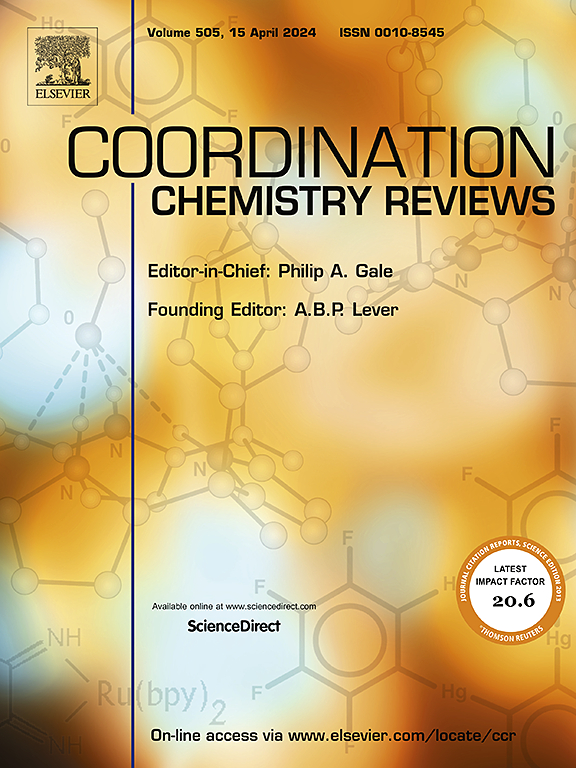MOF/MXene杂化复合材料的合成策略、功能化及生物医学应用
IF 20.3
1区 化学
Q1 CHEMISTRY, INORGANIC & NUCLEAR
引用次数: 0
摘要
金属有机骨架(mof)由金属离子和有机连接剂构成,具有优异的孔隙结构、通用性和多功能性等优点。MXenes是一类新的二维过渡金属碳化物和氮化物,由于其优异的导电性、机械稳健性和亲水性而引起了人们的广泛关注。然而,mof存在不稳定性和低导电性等问题,而MXenes容易氧化,这可能会损害结构完整性并降低功能。MXenes和金属有机框架(mof)的集成创造了可以解决这些问题的尖端开发材料。本文综述了MOF/ mxeni基复合材料及其衍生物的合成策略和表面功能化。MOF/MXene杂合物的合成策略主要有原位混合和非原位混合两种途径。研究了MOF/ mxene基复合材料的表面功能化,如原位聚合。这些功能化策略为MOF/ mxene基复合材料带来了潜在的生物医学应用,如药物输送、伤口愈合、抗生素和生物传感活性。尽管存在毒性和生物相容性等诸多问题,但MOF/ mxeni基复合材料及其衍生物仍有广阔的应用前景。本文章由计算机程序翻译,如有差异,请以英文原文为准。

Synthesis strategies, functionalization, and biomedical applications of MOF/MXene hybrid composites
As constructed by metal ions and organic linkers, metal-organic frameworks (MOFs) have many benefits such as exceptional pore structure, versatility, and multi-functionality. MXenes are a new class of two-dimensional transition metal carbides and nitrides, and have attracted significant attention due to the exceptional electrical conductivity, mechanical robustness, and hydrophilic nature. However, MOFs suffer difficulties such as instability and low electrical conductivity while MXenes are susceptible to oxidation, which can compromise structural integrity and diminish functionality. The integration of MXenes and metal-organic frameworks (MOFs) has created cutting-edge developing materials that can solve these problems. Herein, we review the synthesis strategies and surface functionalization of MOF/Mxene-based composites and derivatives. The synthesis strategies for MOF/MXene hybrids primarily employ with two main pathways including in-situ and ex-situ mixing methods. The surface functionalization of MOF/Mxene-based composites such as in-situ polymerization was examined. These functionalization strategies bring MOF/MXene-based composites for potential biomedical applications such as drug delivery, wound healing antibiotic and biosensing activities. Although there are many issues such as toxicity and biocompatibility, MOF/MXene-based composites and derivatives may be still applied in the diverse fields.
求助全文
通过发布文献求助,成功后即可免费获取论文全文。
去求助
来源期刊

Coordination Chemistry Reviews
化学-无机化学与核化学
CiteScore
34.30
自引率
5.30%
发文量
457
审稿时长
54 days
期刊介绍:
Coordination Chemistry Reviews offers rapid publication of review articles on current and significant topics in coordination chemistry, encompassing organometallic, supramolecular, theoretical, and bioinorganic chemistry. It also covers catalysis, materials chemistry, and metal-organic frameworks from a coordination chemistry perspective. Reviews summarize recent developments or discuss specific techniques, welcoming contributions from both established and emerging researchers.
The journal releases special issues on timely subjects, including those featuring contributions from specific regions or conferences. Occasional full-length book articles are also featured. Additionally, special volumes cover annual reviews of main group chemistry, transition metal group chemistry, and organometallic chemistry. These comprehensive reviews are vital resources for those engaged in coordination chemistry, further establishing Coordination Chemistry Reviews as a hub for insightful surveys in inorganic and physical inorganic chemistry.
 求助内容:
求助内容: 应助结果提醒方式:
应助结果提醒方式:


